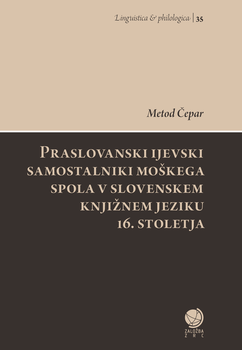Praslovanski ijevski samostalniki moškega spola v slovenskem knjižnem jeziku 16. stoletja
The main part of the monography ('Proto-Slavic Masculine i-Nouns in Slovenian Literary Language of the 16th Century') is the analyze of the reflexes of Proto-Slavic i-stem nouns of masculine gender in Slovenian literary language of the 16th century.
The Proto-Slavic i-stem nouns of masculine gender in Slovenian literary language of the 16th century can reflect as nouns of o-stem masculine, i-stem feminine, i-stem masculine (gospod “sir", ljudje “people", partly also, pot “path"), u-stem (circumflected monosyllables), a-stem and in the plural mixed i-stem and o-stem (masculine) or mixed i-stem and o-stem (miš ˮmouseˮ) declension. Mostly the reflexes of i-stem declension are limited to individual case form and are not reflected in the overall paradigm. There is the increased conservation of i-stem declension in plural while in the singular the transition to o-stem patterns is larger.
There are 55 reflexes of Proto-Slavic i-stem masculine nouns in the Slovenian literary language of the 16th century. These are: cesar, čmrlj, črv, dever, drob, glad, gnus, golob, gos, gospod, gost, gozd, hot, jagned, jastreb, kmet, kol, labod, laket, ljudje, los, luč, medved, miš, molj, mozelj, možgani, noht, ogel, ogenj, olov, os, pastir, peč, pečat, pelin, plat, pleš, pleša, pot, razpot, risa, seženj, snet, srd, sred, tast, tat, trst, zet, zver, žal, želod, žerjav, žolč.
Downloads

Series
Institutes
License

This work is licensed under a Creative Commons Attribution-NonCommercial-NoDerivatives 4.0 International License.
